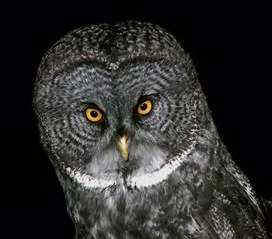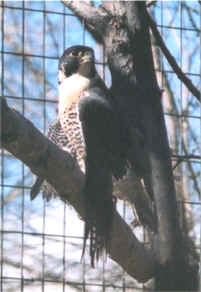All About Birds Pg 2
The Raptors
Birds of prey or "raptors" are meat eating birds that use their
strong feet, talons and hooked beaks to catch and kill their prey. This
group includes eagles, osprey, hawks, owls (Great
Horned Owl), kites, harriers, buzzards, merlins,
vultures, goshawks and condors.
They eat small mammals such as mice and rabbits, fish, snakes, and even other
birds. Some catch and kill their food and others (like vultures) feast
on the leftovers other hunters leave behind.

bald eagle
Birds don't have teeth... Can you guess why? Teeth are heavy and would make it very difficult for birds to fly. This is especially important for birds of prey who must fly swiftly to catch their food. Birds "chew" their food inside a part of the stomach called the gizzard. The gizzard has strong muscles which grind the food against a rough inner surface to break it down.

owl
I spy with my little eye...
Raptor eyes are so big that they cannot move them. The bird has to turn its entire head to look around (that's where the idea that owls can spin their heads around comes from... They can't really, but they can turn their heads a LOT farther than we can!)
The eyes of a raptor are so important for their survival, that they have three eyelids. The third one is partially see-through (partly "transparent") which allows the birds of prey to protect their eyes when attacking prey and still have some sight.
Birds of prey have eyesight that is at least two or three times better than ours. Some can see a grasshopper from the other side of a football field! Golden eagles can spot a rabbit from over a mile away and owls have great night vision so they can hunt in the dark.

hawk
Raptors that spend a lot of time soaring above the ground in search of prey have long broad wings that allow them to catch rising air currents and soar through the air. Soaring saves energy because the bird doesn't have to flap its wings to stay aloft. Soaring also makes it harder for a potential meal to spot the bird of prey.

Raptor Babies
No matter what type of animal we're talking about, babies are cute -- but they're also a lot of work.
From just before the eggs are laid to midway through the nesting period, the male bird is busy hunting for food for the female and babies.
Most birds of prey lay one to six eggs, but they don't lay them all at once. They wait a day or two after each egg before laying the next. The first chick to hatch is bigger than the others and may actually kill it's younger siblings if food is scarce. I'm sure all of us oldest children have envied the raptors once or twice in our lifetimes.
The length of time it takes for the babies to get large enough to start flying is called the "fledgling period". This can be anywhere between 20 and 150 days. This is a big part of the raptor parents' life! Especially since they lay eggs every year.

Peregrine Falcon
Scientific information: Raptors are part of two scientific "orders" Falconiformes and Strigiformes. Falconiformes are "diurnal" which means they hunt mainly during the day -- for example, eagles, hawks and falcons. This order includes four "families" -- Cathartidae (vultures), Accipitridae (hawks, eagles and kites), Pandionidae (osprey), Falconidae (falcon and kestrel).
Stringiformes is just a fancy way of saying owls. This order includes two "families" -- the Tytonidae (barn owls) and the Strigidae (all other owls).